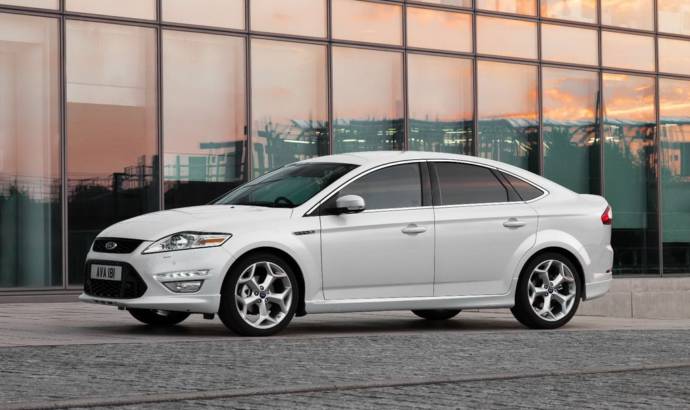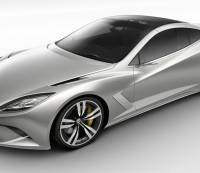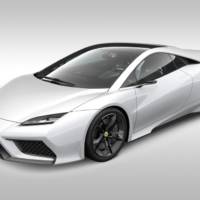The new Ford Mondeo ECOnetic is being presented at the Motor Show in Paris these days, along with the Ford Ka TDCi, both vehicles offering impressively low CO2 emissions and fuel consumption.
The Ford Mondeo ECOnetic will feature Auto Start Stop as standard plus the 1.6-litre Ford Duratorq TDCi engine developing 115 PS (85 kW) which uses a six-speed manual gearbox, will also be equipped with diesel particulate filter.
The new Ford Mondeo ECOnetic promises CO2 emissions of 115g/Km, while consumption figures are yet to be announced.
As for the new Ford Ka TDCi, the 1.3-litre unit powering it will require 4.3 litres of fuel per 100 Km (57.4 mpg US / 68.8 mpg UK) with CO2 emissions of also 115 g/Km.
The Ford Mondeo ECOnetic will hit the market towards the beginning of 2011, with pricing expected to get announced as we get closer to the on sale date.
Ford press release :
* New Ford Mondeo ECOnetic model with CO2 emissions of 115 g/km.
* Ford Ka gets standard Ford Auto-Start-Stop technology: TDCi model delivers 109 g/km.
* Ford is on track to surpass its goal of a 30 percent reduction in CO2 emissions from its new vehicles by 2020, relative to a 2006 model year baseline.
PARIS, 30 September, 2010 – Ford of Europe is further accelerating its efforts to deliver improved fuel economy for customers across its vehicle range with the launch of two important new Ford ECOnetic Technology models at the Paris Motor Show – the new Ford Mondeo ECOnetic and the Ford Ka TDCi with standard Ford Auto-Start-Stop technology.
The introduction of these new models follows Ford’s substantive contributions to lower CO2 mobility already delivered to European customers in 2010. So far this year, the company has introduced its new range of Ford EcoBoost turbo-charged direct injection petrol engines as well as significantly improved and new versions of its powerful yet fuel-efficient Duratorq TDCi diesel engines across its line up.
Also new are the Ford ECOnetic Technologies collection of features designed to help customers equip their car with technical equipment specifically aimed at greener and more fuel efficient motoring. Features such as Ford Eco Mode and Smart Regenerative Charging have been introduced widely in the Ford range, and these combined with the new Ford Ka TDCi and dedicated Mondeo ECOnetic models ensure that Ford of Europe is on track to surpass its goal of a 30 percent reduction in CO2 emissions from its new vehicles by 2020, relative to a 2006 model year baseline.
New Ford Mondeo ECOnetic: 115g CO2 and standard Ford Auto-Start-Stop
The new Ford Mondeo ECOnetic model will be the most frugal Mondeo to date, and will go on sale from the first quarter of 2011.
The new Mondeo ECOnetic features a specially calibrated 115 PS (85 kW) version of the 1.6-litre Ford Duratorq TDCi engine equipped with a standard diesel particulate filter and coupled to a Ford Durashift 6-speed manual transmission with a longer final drive of 1:3.69 (compared to 1:4.06 for the standard Mondeo) and purposefully matched ratios across all gears.
Key to the new Mondeo ECOnetic’s performance is the standard Ford Auto-Start-Stop system which can reduce fuel consumption and CO2 emissions by up to five per cent in mixed driving conditions. In an urban environment and in heavy traffic with frequent stops the savings could increase to as much as 10 per cent.
Ford Auto-Start-Stop features an enhanced and very durable starter motor to support the increased number of engine starts and a stronger pinion-engagement mechanism with reduced noise levels.
A high performance Improved Flooded (IF) Battery with aVoltage Quality Module (VQM) completes the system. It maintains the energy supply to electrical components like the entertainment systems during the re-starting phase of the engine. In addition a Battery Monitoring System (BMS)continuously monitors the Battery status and communicates with the Ford Auto-Start-Stop system, so the system will leave the engine running in the event that the battery does not have a sufficient level of charge.
An integrated system of sensors is used to detect when the driver performs an action that signals the intent to drive off, such as pressing the accelerator or clutch pedal.
As soon as the driver prepares to move away, the engine starts quietly and almost instantly – it only takes the system around 0.3 seconds to fire up. The process is virtually imperceptible, and happens before gear selection is completed.
The new Mondeo ECOnetic model also includes a special aerodynamic kit including lowered suspension and low rolling resistant tyres. The combination of all of these detail changes means the second generation Mondeo ECOnetic is targeted to deliver a combined fuel consumption lower than 4.3 l/100km (more than 65.6 mpg)*, which translates into average CO2 emissions of 115 g/km – an important tax break point in some European markets.
Prioritising fuel efficiency does not have to come at the expense of luxury, as the new Ford Mondeo ECOnetic will be available across all Mondeo bodystyles and series except for the Titanium S.
The newly introduced Mondeo range also includes a number of available Ford ECOnetic Technologies like Smart Regenerative Charging, the Ford Eco Mode driver information system and an Active Grille Shutter system.
Ford Ka with Ford Auto-Start-Stop
With the addition of Ford Auto-Start-Stop technology the Ford Ka is now an even more efficient city car where frequent stops at traffic lights and queues due to heavy traffic are the norm.
Ford is now equipping both available engines options for the Ka with Ford Auto-Start-Stop system as standard from November 2010. Both engines will also meet the Euro V emission levels.
This change improves the nominal fuel economy and CO2 emissions by 3 per cent for both engines. The 1.2 litre Ford Duratec petrol engine delivers a combined fuel consumption of 4.9 l/100km (57.6 mpg)* and average 115 g/km CO2, while the 1.3-litre TDCi diesel engine achieves an impressive fuel consumption of 4.1 l/100km (68.8 mpg)* and CO2 emissions of only 109 g/km.
The Ford Auto-Start-Stop system in the Ka features an advanced battery, a reinforced starter motor and a more powerful alternator. The voltage stabilizer module and a battery sensor take care of the battery’s charging status and the power supply to the electrical components during the cranking phase.
In order to help the driver to reduce the real world fuel consumption as far as possible, the Ka’s instrument cluster now also features a shift indicator light.
Ford EcoBoost – State-of-the-art Petrol Engines
The transformation of Ford’s petrol engine range has been led by the introduction of two state-of-the-art 4-cylinder engines as part of the company’s global Ford EcoBoost family.
These engines represent a completely new generation of downsized, high-efficiency, low-CO2 petrol engines from Ford. Developed by Ford engineers based in Europe, the 4-cylinder EcoBoost engines combine high-pressuredirect injection, advanced turbocharging and twin variable valve timing to maximise combustion efficiency.
The primary benefits delivered by the Ford EcoBoost design approach include:
* Optimised engine efficiency – fuel consumption and CO2 emissions are reduced by up to 20 per cent compared to conventional, larger displacement engines
* Greater driving enjoyment – strong low-end torque and responsive performance is delivered across the full rev range
* Opportunityto downsize – the best of both worlds – large engine performance but with the size, weight and fuel economy of a much smaller unit
The 4-cylinder Ford EcoBoost engines are available as either a 1.6-litre unit with outputs of 150 PS and 180 PS, or a 2.0-litre for applications of 200 PS and above.
The 1.6-litre Ford EcoBoost engine is being launched in the all-new C-MAX and Grand C-MAX models at the end of this year and will be followed by the next-generation Focus in early 2011. The 2.0-litre engine with 203 PS has been launched in the latest S-MAX, Galaxy and new Mondeo models, while a 240PS version is available in the new Mondeo and the S-MAX.
Ford EcoBoost engines are a central element in the company’s global powertrain strategy, with annual sales expected to exceed 1.3 million units by 2013. In addition to the two 4-cylinder engines, this total also includes the 3.5-litre V6 engine already available in larger vehicles in North America, and a future small displacement engine which will be produced in Europe.
"Fuel economy is one of the biggest drivers for a customer, when choosing a car. With efficient new powertrains and Ford ECOnetic Technologies extending across more of our vehicles, we offer affordable solutions for a large range of customers that make a real contribution to reducing the carbon footprint of automotive mobility," said Stephen Odell, Chairman and CEO, Ford of Europe.
* All CO2 emissions figures in g/km and fuel consumption figures are from officially approved tests in accordance with EC Directive 93/116/EC. Fuel economy figures quoted are based on the European Fuel Economy Directive EU 80/1268/EEC and will differ from fuel economy drive cycle results in other regions of the world.
Note: This information reflects preliminary specifications and was correct at the time of going to print. However, Ford policy is one of continuous product improvement. The right is reserved to change these details at any time.

30 Sep 2010
0


